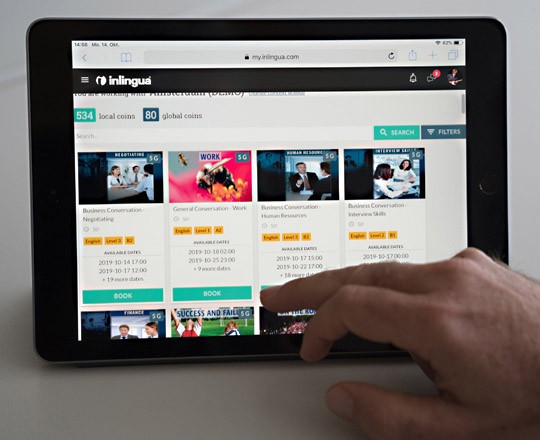Success Story Inlingua
Learning languages with digital assistance
With the help of Cisco Webex, Inlingua started using virtual classrooms in 2009. The language service provider thus became a pioneer and, with the conferencing tool, also provided the impetus for the development of a learning platform and app. Today, many students use the online solutions instead of (or in addition to) face-to-face tuition.
Text: Christoph Widmer, Images: Tomas Wüthrich,
With 300 language centres in over 40 countries across Europe, North and South America, Africa and Asia, and millions of customers – private individuals as well as employees of large and small companies, institutions and government authorities – Inlingua, which was founded in Berne in 1968, is now one of the world’s leading language service providers. Thanks to its broad international network, Inlingua felt the pressure of digitisation at an early stage. Just like its customers: “In the French, Italian and Spanish markets especially, digitisation was a hot topic ten years ago, not least because of the financial crisis,” explains Peter König, Inlingua’s Head of Business Services. “Our corporate clients were looking for more efficient and cost-effective ways to help their staff learn foreign languages. That’s why we felt the need to digitise our services early on.”
In 2009, Inlingua therefore launched the digital transformation of its own business and looked for suitable tools that would enable it to offer its customers easy, inexpensive access to language courses. To this end, it set up several project teams to evaluate various solutions and providers.

Peter König, Head of Business Services at Inlingua, remains convinced of the benefits of online language tuition.
Cisco Webex: remote language-learning
The final choice was Webex, Cisco’s video-conferencing solution, integrated by Swisscom. Thanks to Cisco Webex, language students no longer have to attend lessons in person because they can interact with language teachers online in a virtual classroom. Teachers provide tuition in the target language fully in accordance with the Inlingua model via webcam and share teaching materials with their students on-screen. Webex therefore enables people from remote or rural areas to take part in Inlingua language courses without the need to travel to a physical classroom. At the same time, it means language centres can offer courses in exotic languages, which was previously impossible because of small class sizes. The individual, independently run language schools access the relevant Webex hosts through Inlingua, while the language teachers learn how to use the solution by means of webinars and self-learning tools.
A team of Swisscom experts was responsible for integrating Cisco Webex and Inlingua remain happy with how the project has progressed: “Our cooperation with Swisscom has been impeccable,” says König. “There has not been much contact since the system was implemented, which I see as a good sign. And if something didn’t work right away, we could call our Swisscom contact at any time and quickly receive the technical support we needed. It was a totally positive experience for us.”
Although the actual implementation of Cisco Webex went smoothly, Inlingua encountered some technical problems with the operation of the solution. The low Internet bandwidths in some countries meant that, at the start, Webex did not work as well in some places as in others. “Time has done us a favour,” says König. “Bandwidths have increased everywhere over the years and I also think Cisco Webex no longer needs as much bandwidth as before. The problem has therefore gone away completely.”

Peter König shows the user interface on the Inlingua website.
A pioneer with innovative follow-up projects
By introducing Cisco Webex, Inlingua acquired pioneer status, becoming one of the first language service providers in Switzerland to offer foreign language tuition in virtual classrooms. Cisco Webex also provided the impetus to launch other digitisation projects. After implementing Webex, the language service provider developed its own e-learning platform, my Inlingua, which provides a one-stop solution for students. All interactive learning exercises and tests can be accessed via this single platform, through which students can also book Webex lessons directly. The conferencing tool was integrated into the learning platform using an API. Inlingua’s latest digitisation project is the Flex-E-Book mobile app. The app can be used to provide tailor-made course content and the appropriate e-book based on the individual student’s level of knowledge and requirements.
Since Cisco Webex was introduced, the number of virtual language courses has been constantly increasing. Several thousand lessons are now given via the video-conferencing solution every month. Peter König is also convinced that Webex has educational benefits: “We talk a lot amongst ourselves about whether a virtual classroom functions as well as a real one. I actually think it’s more efficient. Students are fully focused on the screen and are not tempted to chat to their neighbour. We also use Webex internally to communicate with our foreign developers. I don’t think these meetings would be as quick and productive if we were all sitting together in the same room.”




